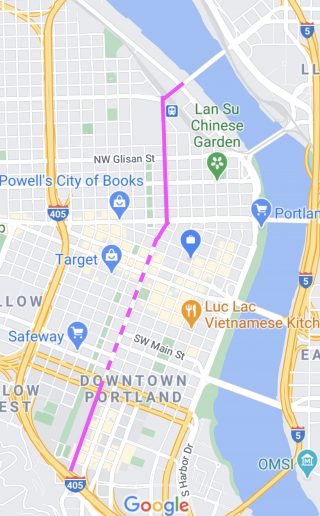
When the Portland Bureau of Transportation installed our city’s first protected bike lane (called a cycle-track back then) on Southeast Broadway adjacent to the Portland State University campus in August 2009, it lacked one crucial element: connection to anything else.
Despite Broadway being one of the most important north-south streets in the central city, that initial project (installed as part of former Mayor Sam Adams’ “First 100 Days” agenda) only went as far north as SW Clay. The goal was to connect all the way north to the Broadway Bridge.
Last fall, PBOT built protected lanes on Broadway from Hoyt to SW Oak; but again this crucial bikeway was left with a major gap through the heart of downtown. (Yes there’s a bike lane the entire length, but it’s a narrow unprotected, door-zone facility that’s woefully outdated.)
Now the full connection is finally within sight: At a meeting last week, PBOT announced they’ll reveal designs and start a public outreach process this spring in advance of finally completing the Broadway bikeway in 2022.
Advertisement
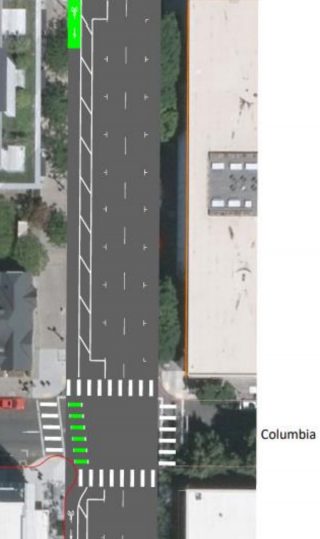
The new design will reconfigure Broadway between Clay and Oak from three general purpose lanes, two parking lanes, and a bike lane to two general purpose lanes, two parking lanes and a wider, buffered bike lane separated from moving traffic by parked cars. Some parking spaces will be removed to improve visibility at intersections.
You might recall that this section of Broadway was part of a “pop up bike lane” demonstration by Better Block PDX in 2016.
Similar to recent changes to NW Broadway, this $500,000 “quick build” project will consist of paint, plastic posts, and signal timing updates. In addition to a southbound protected bike lane from Oak to Clay, PBOT will create a one-block, contraflow bike lane between SW Harvey Milk and Oak to connect the bikeway to SW 4th.
PBOT says new signal timing will separate bicycling, walking, and driving behaviors at some intersections that will have new right-turn only lanes. Another element of the project will be what PBOT calls “high visibility crosswalks” where yellow-ish “beeswax”-colored pavement color will be used (similar to NE Multnomah through the Lloyd) to cheaply create more space in the road where walkers can wait and shorten crossing distances. A PBOT staffer called them “visual pedestrian step-out zones” that will eventually be filled in with concrete.
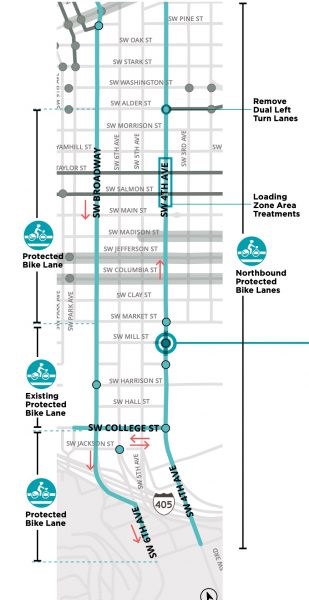
The creation of a “signature” north-south protected bike lane couplet on Broadway and 4th between I-405 and the Broadway Bridge is part of PBOT’s 2018 Central City in Motion plan. Fixing this gap would complete the southbound leg of the couplet. The northbound facility on SW 4th is taking much longer because it’s a full-fledged capital project (as opposed to a quick-build). The latest update from PBOT is that the 4th Ave project will break ground in 2022.
Stay tuned for more info on the Broadway plans. PBOT plans to start public engagement in the next month or so.
— Jonathan Maus: (503) 706-8804, @jonathan_maus on Twitter and jonathan@bikeportland.org
— Get our headlines delivered to your inbox.
— Support this independent community media outlet with a one-time contribution or monthly subscription.



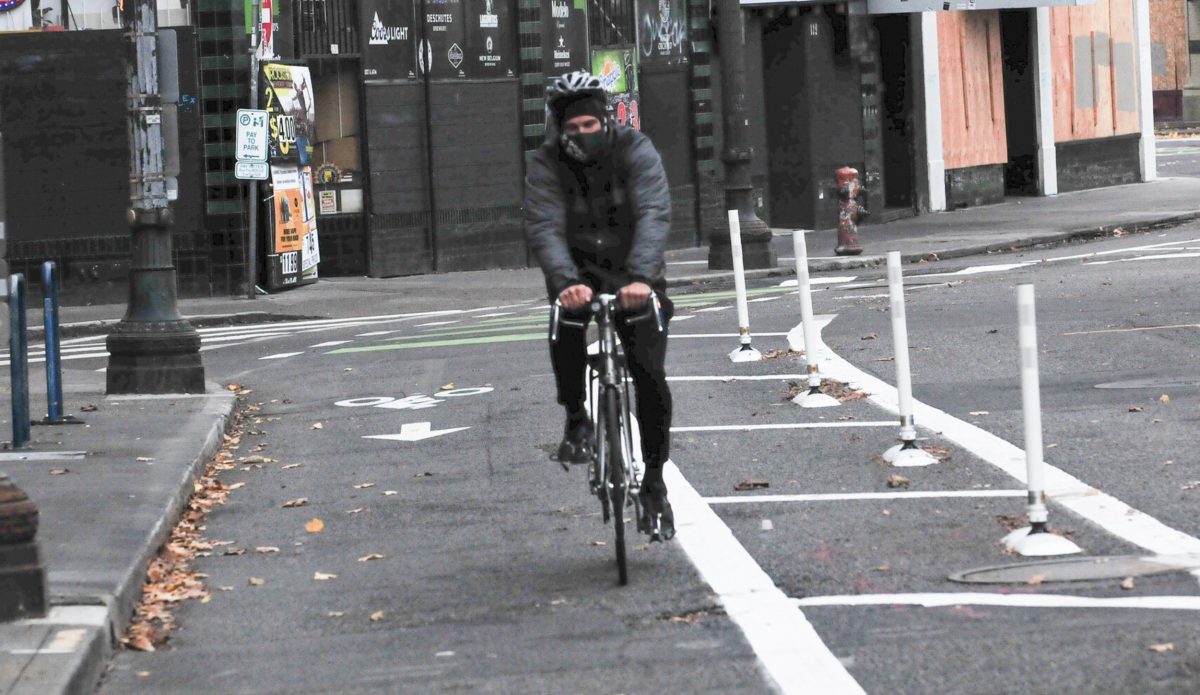

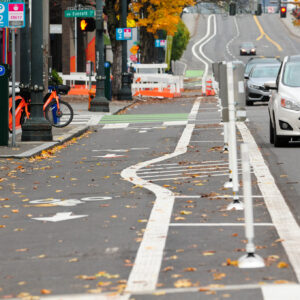
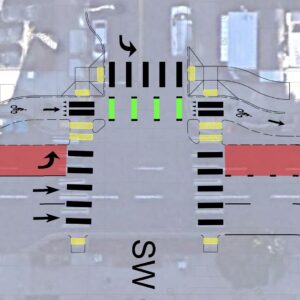

Thanks for reading.
BikePortland has served this community with independent community journalism since 2005. We rely on subscriptions from readers like you to survive. Your financial support is vital in keeping this valuable resource alive and well.
Please subscribe today to strengthen and expand our work.
I hope at the very least SW Washington and SW Clay will have signal separation and protected intersections if only in planter form. It’ll be amazing to finally not have to ride in the center of a traffic lane downtown.
Re how much visibility at intersections (and throughout): what is the design speed for bikes? Same as the speed limit (20mph)?
This turns a bit uphill right around Taylor, so presumably visibility at design speed shouldn’t be an issue for bikes. I rarely exceed 10-12mph there.
You go 20mph here and you’ll be stopping every block for a red light.
IIRC the one-way roads downtown are designed for 15 mph travel to hit every traffic light green.
The design speed actually varies between about 13 and 18 mph depending on which signal timing program is in place at the moment, as I have learned. This varies by time of day and day of the week (though it can be overridden for events).
One of the tools to make PBLs safer and is used quite often in european countries as well as NYC is to time the lights to bike groups or “waves” such that it is virtually impossible for drivers to not see a cyclist and right hook them. PBoT can easily set signal timers can easily set signal timers to a steady average bike pace, relative to specific stretches. This is also one of the most overlooked benefits to PBLs: safety in numbers. And Broadway will be one of the busiest streets in the city once this connection is finally completed.
Whatever the speed limit is for cars on this street, bike infrastructure should be designed to match. Anything less is an abdication of traffic engineers responsibility to prioritize effective and safe movement by bike.
Hey Steve I think I agree with the sentiment, but in practical terms it makes little sense. One could say that all modes should be designed to match, eg pedestrians infra should also be designed for people walking at 25mph. That bikes and cars both have tires, do not make them act the same. There are areas where engineers design PBLs to purposefully slow peds/bikes (but not cars) such as at protected bus stops. Signals on bway and 4th should be retimed for average bike speed downtown, not cars, which would make this point moot.
My point is that the bike lanes and “protected intersections” should be designed to promote safe and efficient movement of bikes. Good sight lines, space to avoid hazards and other cyclists. I see a lot of tight bends and pinch points in various bike friendly infrastructure renderings and I was pointing out the continued primacy and affordances given to cars in these designs. In order to make bicycles a viable transportation option for more people, they need to be allowed to move as freely as possible.
If it’s possible to make a light by riding at 20mph but the intersection requires swerving and navigating a tight pinch point at maybe 10mph, that is a failure of design and priorities.
I think we proly agree in the spirit of policy. Consider a couple different intersections as a case study: Clay and Broadway (which is at the end of a steep downhill) and Jefferson and Broadway (which is at the end of a fairly long uphill segment). It’s likely at Jefferson, people on bikes will be going 20mph. Signal separation (and straight, no-jog design) is crucial to safety here due to high risk of right hook. PBoT may try to sell their odd jog design at Glisan/Bway, but I am very skeptical of that silly thing (and unaware of any research on such a design).
As others have noted, in downtown the “speed limit” is set by the signal timing, and is about 15 mph. I’m guessing the legal speed limit is 25 mph, but if you do that you’ll hit a red light in short order.
I s this where are the hotel drop zones are? How are those being resolved?
Yes the infamous Benson Hotel zone will be impacted by this. As to your question: I’m not sure yet. PBOT hasn’t released many details yet and I expect to learn more as they roll out the public engagement in the next month or so.
At least with a traffic lane gone there will be more space.
By the way, I’ve had at least as much trouble with the Heathman Hotel zone as the Benson, if not more.
I don’t know, but in Seattle they’ve resolved this with a small step off zone in between the parking lane and the bike lane. If they don’t have the money to do that with concrete in this project I imagine they could do it with a ZICLA platform.
I remember when the SW Broadway stretch of bike lane was put in, sometime in the early 2000s. Coincidentally, I was taking the Portland Traffic and Transportation class at the time, and the universal agreement among everyone in the class (including our venerable instructor) was that it was awful. And it has been awful since, especially in the hotel zones, although the conflict with right turns onto Taylor has become a little less terrible.
Remember this when you find PBOT compromising on poor bike infrastructure: you may have to live with it for a VERY long time. Hawthorne, anyone?
Would you have preferred to have no bike lane on Broadway for the last 20 years?
I did a daily commute from North Portland, across the Broadway bridge, and through downtown for several years. While I found the Broadway bike lane to be awful, mostly due to hotel traffic and private for hire vehicles loading or unloading in the middle of the bike lane or randomly opening doors without warning, I would not have opted for no bike lane if given the option.
I would have loved it if PBoT had taken out the standard bike lane, which often served as a loading zone. I learned after years of attempting to ride in it, having dozens of close calls, it was a lot safer to simply ride in the center of the lane. Standard bike lanes are more dangerous in some cases than no bike lane at all.
I did this same commute before the pandemic and just never took Broadway because it’s such a cluster. Bad bike infrastructure is worse than no bike infrastructure because it allows our city to keep focusing on SOVs while maintaining their green cred in the planning community by allowing PBOT to pretend it’s building bike infrastructure
I’m certainly not suggesting that this terrible bike lane was worse than if there had been no bike lane. My point is that even half-*** infrastructure tends to get locked in for decades, and that it’s worth fighting for something better.
I thought Cully/57th was the first barrier-protected bike lane. Or is it a cycletrack? When was that section along Multnomah next to Lloyd Center put in, the one with potted plants?
I’m pretty sure both Cully and Multnomah happened well after the one on Broadway near PSU.
Um, big yawn? Just what we need, more uncleanable gutter bike lanes full of crappy pavement, wet slippery leaves and other debris!
What would you recommend?
I see this as a huge step forward. I feel like cleanliness is a different issue. We need more biking infrastructure. But we also need more bike lane street cleaners. Just because the lanes can get slippery does not mean that they should not happen.
As someone who dodged opening car doors and was once run off into the curb by a motorist diving for an on-street parking space, I’ve avoided the Broadway bike lane for years now. Broadway has never really needed 3 travel lanes – even at rush hour. The buffered bike lane near PSU is positively serene compared to the rest, and extending this type of treatment north will be a welcome change that should have occurred years ago. Better late than never.
This will be a great improvement. I’d prefer poured concrete dividers to separate the bike facility from cars, but wands and paint are better than nothing.
I wish PBOT would abandon the left hand alignment on the 4th Ave bike facility when they get around to building it in 2022.
Between Broadway, 4th, and Naito there is a lot of north-south improvements coming. Anything happening with east-west in downtown? Flanders? Anything else?
I wonder if there’s any chance PBOT could close Yamhill and Morrison to private cars entirely, making them public transit and bike only. They’d be a logical pair to try this out on.
And on the south edge of downtown Montgomery is extremely low-hanging fruit; the only blocks currently open to car traffic at all are between 4th and 5th, and 10th and 11th. Really don’t see why they couldn’t just close the former entirely, and the latter is low-traffic enough that I’m not concerned about changing it.
No kidding! I was right hooked just yesterday at the intersection with Washington St. Luckily I was defensive and had slowed down enough that only the tail end of the car caught my front wheel and I fell relatively soundly to the side at almost 0 mph. If it was most riders it could’ve been a lot worse… This is so overdue.
Great to see this improvement finally come to light!